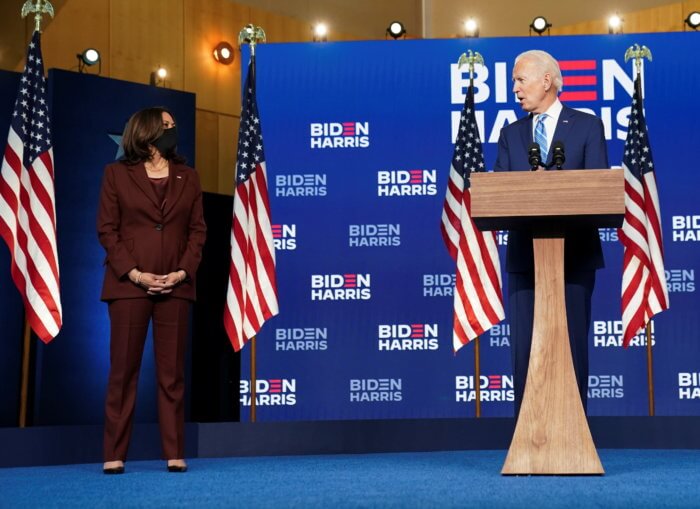In an election contest that proved startlingly close for progressive voters eager to oust President Donald Trump, former Vice President Joe Biden seems on course to capture the White House, with states totaling 253 electoral votes — 17 short of those required for victory — called for him, versus just 214 for Trump. As Gay City News goes to press in the early evening of November 4, six states have not yet been called.
But two of those six — Arizona and Nevada — give Biden a lead that he seems likely to hold. Together, they would deliver the required additional 17 electoral votes.
With 86 percent of the vote counted in Arizona, which a Democrat has not won since 1996, Biden enjoys a 93,000-vote lead. In order to overtake the former vice president, Trump would need to show a 21-point advantage over him in a race where Biden is currently up by more than five points. The Arizona results have convinced both the Associated Press and Fox News to call the state for Biden.
Democrat inexorably zeroes in on 270 electoral votes, as party otherwise faces election disappointments
In Nevada, Biden’s lead is far smaller — less than 8,000 votes or under one percent, also with 86 percent of the vote counted. But there, the uncounted vote is absentee ballots, which were sent to Democrats by a very wide margin. No further data is expected from that state, however, until late Wednesday evening or more likely Thursday.
Of the other four uncalled races, Alaska’s three electoral votes will go to Trump. The tally in North Carolina, with 15 electoral votes has been stalled all day, with Biden down 1.5 percent or about 77,000 votes, with an estimated five percent still uncounted. North Carolina last went Democratic in 2008.
The final two — Pennsylvania and Georgia, with 20 and 16 electoral votes, respectively — began the morning after the election with huge Trump margins that have declined steadily as urban areas including Atlanta, Philadelphia, and Pittsburgh have reported their numbers. Biden is now down by under 50,000 votes in Georgia —which last went Democratic in 1992 — with five percent of the vote outstanding. In Pennsylvania, Biden remains down just under 250,000 votes, but he cut his deficit by well over 50 percent throughout Wednesday and 14 percent of the state votes remains to be counted.
Significantly, Nate Silver of fivethirtyeight.com, rates Pennsylvania as “lean Biden” and Georgia a “toss-up,” but “lean Biden” if you force him to pick.
In any event, the combination of wins in Arizona and Nevada would make Pennsylvania and Georgia superfluous — gravy, as it were.
As the Electoral College drama plays out, Biden has already accumulated a popular vote lead of almost 3.5 million.

Despite the positive news on the presidential front, in the crucial battle for control of the US Senate, Democrats, buoyant about their chances of a flip in the days leading up to the election, appear unlikely to achieve that goal. And with the apparent election of the Biden ticket, Democrats need a net gain of only three seats to achieve 50-50 split that would be resolved by the vote of the incoming vice president, California Senator Kamala Harris.
In an election night that proved jarring for many Americans who hoped to avoid a repeat of Trump’s 2016 upset victory, one of the most surprising results came from exit polls suggesting that the president had dramatically improved his standing with gay, lesbian, bisexual, and transgender voters. Four years ago, Hillary Clinton bested Trump by a 78-14 percent margin in a contest with several well-known minor party candidates. This year, exit polls showed Biden earning only 61 percent of the community’s vote versus a shocking 28 percent for the president — historically one of the best performances for a Republican presidential candidate.
Gay City News, analyzing that exit poll finding, recognized that it was not backed up with comparable numbers at the individual state levels. In many states — including large ones like California, Texas, New York, and Illinois, no breakdown of the LGBT vote was shown, and in Florida, arguably the second most conservative of these big five states, the break was reported at 80 to 17 percent in Biden’s favor.
Associated Press, which conducts the exit polls, did not respond to a request for comment clarifying these confounding results. And a representative from a leading national LGBTQ advocacy group, speaking off the record, confirmed this newspaper’s doubts about the quality of the national estimate.
Biden appears to have prevailed on election day by rebuilding at least two of three blue wall states of Michigan, Wisconsin, and Pennsylvania, that Clinton lost — by narrow margins in each of the three — and likely flipping Arizona from its 2016 results and, also likely, holding Nevada.
Significantly, however, Trump demonstrated a strong pull with white voters, who favored him 57 to 42 percent — white women preferring him 55 to 43 percent — while Black voters preferred Biden 87 to 12 and Latinx voters supported him 66 to 32.
As polls closed around the nation on November 3, it soon became clear that the contest would play out far longer than viewers — on both sides of the aisle — hoped and that Biden was not in fact positioned to earn the Electoral College landslide that some thought possible. Several southeastern states where polling averages reported by fivethirtyeight.com suggested a Biden win — including Florida, Georgia, and North Carolina — did not deliver for the former vice president, at least not initially.
In the end, Trump prevailed in Florida by nearly 380,000, or 3.4 percent of the total. Pundits attributed Biden’s problems to the softness of his support among Latinx voters — especially Cuban Americans and some other immigrants who faced a barrage of Spanish-language Trump ads tying the Democrat to socialism and the unpopular legacy of Fidel Castro and other left-wing Latin American leaders. According to NBC News, Trump captured 55 percent of Cuban American voters and 48 percent of non-Puerto Rican “other Latinos.” The president’s share of Puerto Rican voters was only 30 percent.
Still, it must be noted that while Latinx voters in Florida went with Biden by a 52 to 47 margin, white voters overwhelmingly supported Trump, 61 to 38.
Texas, where pre-election polling showed Biden as surprisingly strong even if behind the president, delivered encouraging early returns for the Democrat, but in the end he fell short by roughly 670,000 votes or about a six-point deficit.
The three contested blue wall states — Pennsylvania, Michigan, and Wisconsin — proved particularly worrisome to Biden partisans. In each state, the in-person election day votes were reported first and skewed toward Republican voters, showing the former vice president with deficits in each, most dramatically in Pennsylvania, which did not begin counting absentee ballots until after the polls were closed.
By Wednesday morning, reports from Democratic strongholds like Detroit, Milwaukee, and Madison put Biden irretrievably in the lead in Michigan and Wisconsin, but wildly uneven procedures that different counties in Pennsylvania employed in reporting in-person, early, and absentee ballots left that state up for grabs throughout the day on November 4.
As Americans were throwing in the towel on an election night call and heading to bed, Biden appeared at an outdoor rally in Wilmington, Delaware, urging patience but reflecting an upbeat spirit.
“As I’ve said all along, it’s not my place or Donald Trump’s place to declare who’s won this election,” Biden said. “That’s the decision of the American people. But I’m optimistic about this outcome.”
Minutes later, Trump took to Twitter to claim, “We are up BIG, but they are trying to STEAL the Election.” Speaking later to an invited crowd at the White House in the wee hours of the morning, the president claimed, “Frankly, we did win this election.”
“We’ll be going to the US Supreme Court,” the president said, suggesting he could get the vote counting halted and adding, “We want all voting to stop.”
During the day on November 4, Biden, with his running mate Harris, once again appeared publicly to urge caution and respect for the principle of every vote being counted. Though he said his team was convinced they had the numbers to reach 270 electoral votes, he did not claim victory.
For his part, Trump continued to issue inflammatory charges about voter fraud for which there was no evidence. With the Wisconsin vote margin less than one percent, his campaign signaled it will exercise its right to demand a recount, while uncredentialed Republican observers swarmed a Michigan vote processing center demanding that the counting be stopped. Police had to be called in. Meanwhile, New York’s hapless former Mayor Rudy Giuliani rushed to Philadelphia promising to expose corruption underway there.
The apparent president-elect, though undoubtedly relieved by his narrow victory, must certainly be disappointed by the Senate results, with the likelihood that he will face obstruction from Republican Majority Leader Mitch McConnell, who won reelection on Tuesday and honed his skills at defying the voters’ will in choosing their president during Barack Obama’s eight years in office.
Democrats picked up two seats — with the victories of Colorado Governor John Hickenlooper and Mark Kelly in Arizona — but lost the Alabama seat won in 2017 by Doug Jones.
A number of hoped-for flips ended up slipping through the Democrats’ hands — including the challenge that Montana Governor Steve Bullock mounted against incumbent Steve Daines, but also surprisingly spirited runs against Joni Ernst of Iowa and Lindsey Graham of South Carolina.
In Maine, Democrat Sarah Gideon, who consistently polled ahead of incumbent Susan Collins — positively theatrical in her anguish during the past four years over her weak-kneed obeisance to Trump — conceded to the incumbent after falling roughly six points down in the race.
As the North Carolina returns remain stalled, incumbent Republican Thom Tillis held onto a lead of nearly 100,000 votes, or a margin of just under two percent.
In Georgia, Democrat Jon Ossoff remains down by about 150,000 votes to incumbent David Perdue, despite charges he engaged in insider trading in response to an official briefing he received on the severity of the COVID crisis — even as he downplayed the threat with Trump-loyalist rhetoric. Whether Biden’s growing numbers in Georgia will pull Ossoff along with him is unclear.
The special election in Georgia to fill the remaining two years of retired Republican Senator Johnny Isakson is headed for runoff on January 5. Though Democrat Raphael Warnock outpolled Senator Kelly Loeffler, the appointee named temporarily to Isakson’s seat, by more than five points, the combined Republican vote among the four top contenders totaled 47 percent versus 39 percent for Warnock and a Democratic also-ran.
To sign up for the Gay City News email newsletter, visit gaycitynews.com/newsletter.
































